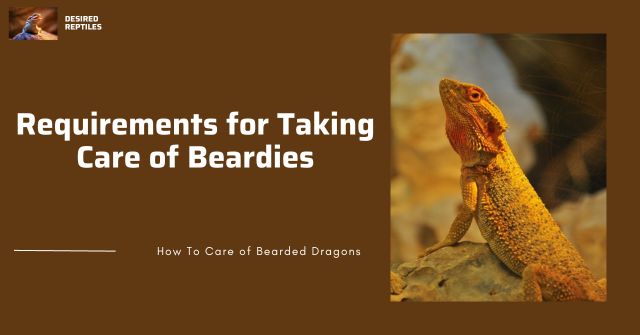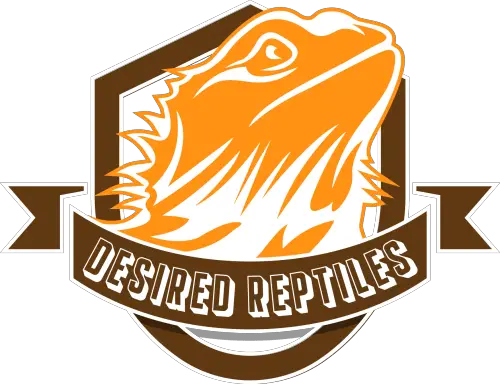Bearded dragons may be hardy, but they’re very delicate pets to take care of. The truth is, keeping a bearded dragon is serious work. They are straightforward, easy to learn and accomplish, but tedious and expensive to nurse. If you’ve made up your mind to own a bearded dragon, you must be ultimately ready to cater to and support your pet with all your love, time, patience, and funds. There are, of course, many ways you can accomplish this, and even better, an article like this one to lay it down for you in easy and direct steps.
Bearded dragons require standard necessities to be properly taken care of. Simply put, you must mimic their natural habitat by providing them with good housing, food, lighting, temperature, and proper interaction. Adequate healthcare must also be provided to confirm your beardie is healthy through and through.

The 10 Most Important Ways To Care For Your Beardie – All The Stuff You Need
There are a lot of precautions in taking care of a bearded dragon. However, the most important aspects have been summarized into 10 direct points as explained below:
1. An Appropriately-Sized Terrarium
Your beardie will not be taken care of properly if the tank size is matched wrongly. It’s important to provide your pet with a reasonable space where it can roam about and grow properly. If you are starting with a baby bearded dragon, I advise you to purchase a 50 – 70 gallon enclosure. Do not buy into the starter pack spaces with 25-gallon terrariums. Getting to a sizable tank is the first step to building the ultimate bearded dragon set-up which is considered important for your pet’s life.
2. The Correct Beardie Diet
Bearded dragons eat grubs, vegetables, and fruits, and drink water in a much more specific pattern than your regular cats or dogs. The protein is mostly made up of insects which are also limited to a few such as superworms, dubia roaches, mealworms, and crickets. The fruits and vegetables are also finite because there are certain veggies that beardies shouldn’t and cannot eat.
As for hydration, beardies need only a few licks of water to sustain them the whole day! The best way to hydrate your bearded dragon is by spraying a few spritzes of water on its head (misting) so that it can lick from the mist and thus, drink water.
You must be aware of what to feed your bearded dragon so that you don’t feed it something rather dangerous to its health. Some vegetables and fruits contain oxalates that are known to cause metabolic bone disease in bearded dragons if there is prolonged consumption of the compound.
3. Feed Your Beardie The Correct Food Rations
Bearded dragons feed based on their age ranges. This is because, for each stage, there is a different type of metabolism and thus different nutrient requirements. Baby bearded dragons experience a fast metabolism, and require to be fed more than the other stages. Whereas adult beardies would rather consume less food daily and eat more vegetables than proteins since they are already developed and experience a slow metabolism.
So, you must take into consideration the age of your bearded dragon so that you can match the correct feeding rations to give it the best care possible.
Below is the blueprint you must follow:
| AGE | Fraction in Percent (Bugs & Veggies) | Number of Insects |
|---|---|---|
| 0 to 2 months (Baby dragon) | 70/30 | 25 – 50/day |
| 3 to 6 months (Juvenile) | 70/30 | 25 – 50/day |
| 7 to 9 months (Pre-Adult) | 60/40 | 20/day |
| 10 to 18+ months (Adult) | 30/70 | 10/day |
4. Guarantee There Is Proper Lighting
Lighting is a very important aspect of bearded dragon care. It consists of the heat-producing light that allows your beardie to bask like it would in the wild and the UVB lamp (view on Amazon) to help it produce vitamin D for the utilization of calcium. Without these lamps, your bearded dragon will suffer from health problems like indigestion and metabolic bone disease.
Guarantee that you go for durable reptile heating and UVB lamps to save you the need to spend extra bucks replacing them in the long run. Also, we don’t want to risk our pets by using destructive resources that can cause them to fall sick.
5. Use The Proper Temperature At All Times
Heating is just as important as lighting for bearded dragons. Beardies need the heat to digest what they eat, regulate their body temperature, and Verify that their immune system is in check! For this, you must have a heat lamp (view on Amazon) to raise the temperature of the tank.
Depending on the size of the enclosure, you may need a 100 – 75 watt bulb. If your tank is above 80 gallons, a 100-watt bulb is your best bet. Without heating, your pet can fall ill with serious impaction that can be life-threatening or a respiratory infection. Hypothermia is also a great risk for bearded dragons without proper heating, especially for baby and senior beardies.
The temperature in the tank should not exceed 104° to 107° Fahrenheit in hot areas and 71° to 73° Fahrenheit in shaded areas. You must provide a thermometer (view on Amazon) inside the enclosure to monitor the temperature so that it doesn’t get too hot or too cold for your pet.
6. Regulate The Tank’s Humidity
Bearded dragons need arid or airy areas to stay healthy. When the enclosure is too humid, your pet will fall ill. The humidity levels must be around 30% to 40% to confirm that your beardie doesn’t contract respiratory illnesses. You can regulate the humidity by increasing airflow in the enclosure. If you live in humid areas, ensure that there are vents around the tank for air to get in and out.
You can also try the rice method; put some rice into a sock and place it inside the enclosure to help trap the loose moisture. For this, a hygrometer is highly necessary to keep a good eye on the humidity (view on Amazon). If it’s too dry, your pet will experience problems shedding. Too humid and your pet will catch the flu, which is fatal by the way.
7. Regularize Appropriate Sanitation
You must keep your bearded dragon’s enclosure clean at all times to prevent it from falling sick. Practice daily, weekly, and monthly cleaning routines to keep bacteria from disrupting your beardie’s well-being. Here are the basic cleaning practices to follow:
Daily:
Make a quick sweep to remove leftover food, poop, and urate from the tank. Also, wipe off the stains these leave behind to prevent the tank from stinking up!
Weekly (Every Other Week):
Every week or every other week, you should clean the inside of the tank with vinegar and water solution or a safe reptile terrarium cleaning agent (view on Amazon) to properly disinfect the tank.
Monthly:
All accessories, wipeable furniture, and food bowls should be thoroughly washed or cleaned by the end of the month. Substrate and flooring should be wiped as well or replaced if necessary.
8. Handle Your Bearded Dragon With Care
Another important aspect of bearded dragon care is handling. You must learn to handle your pet with care to prevent it from getting stressed by the situation. Bearded dragons react to stress quite differently from most pets; when they’re stressed, even their immune system takes a toll. Pick up your bearded dragon from underneath the belly, not the tail, neck, or limbs!
Beardies also enjoy being petted when you stroke their heads gently and carefully. It’s important to handle your pet with caution as this will build trust between you and your pet, and allow it to grow healthily and happily in its environment.
9. Pay Frequent Visits To The Vet
Veterinary visits are necessary to ensure that your pet is not suffering from any asymptomatic health problem. You can schedule visits with the reptile specialist monthly and especially when you find your pet acting strangely.
Common symptoms that tell your pet is suffering from a problem are:
- Lethargy
- Stress marks (darkening of the beard, belly, and tail)
- Loss of appetite
- Impaction
- Frequent bobbing
- hand waving
- Sudden aggression
- Hiding habit
- Droopy eyelids
- Stargazing (head sticking upward accompanied by a weird arching pose)
- Pale skin
- Heavy breathing
- Strange walking steps
- Bumps or contortions around limbs, back, or tail
10. Keep Your Bearded Dragon Stimulated
Beardies can get bored and suffer from the lack of stimulation by prolonged use of routines and mental inactivity. This could cause them to be seriously lethargic, obese, and timid. You must engage your pet in mentally stimulating activities by providing toys or creating an engaging enclosure with colorful accessories now and then.
You can even take your pet on walks provided you get a leash or a carrier to keep it from running out of sight. Beardies are curious and intelligent little critters and they absolutely enjoy the idea of adventure. However, you must never keep your pet out of its enclosure for too long. At most 3 hours of fun time is just fine.
How Do I Care For My Baby Bearded Dragon?
Baby beardies are voracious feeders. They require to be fed three times more than adult beardies and need to be handled quite less as they’re still fragile and quite skittish. The feeding table guide drafted earlier in this article will give you an outlook on how to feed your baby beardie so that you provide it with all the nutrients it needs to grow big and strong. Aside from this notice, everything else you need to care for your baby lizard has been addressed in this discussion.
How Do I Care For My Pregnant Bearded Dragon?
Pregnant beardies require a load of nutritious veggies and treats to help replenish the nutrients used to develop the eggs. Supplements are as well highly necessary for the ts diet to ensure she’s healthy and strong. Toward the end of her pregnancy, you must provide a lay box where she can bury her eggs separately from her enclosure.
Do not use your pregnant beardie’s enclosure as a lay box. After laying, if your beardie displays strange behavior like lethargy or the inability to move, rush to the vet immediately for it could be egg-bound! Egg binding is a terrifying common and fatal situation where the egg is unable to be laid, and this can cause serious complications for your bearded dragon.
How Do I Care For My Senior Bearded Dragon?
Senior beardies are much less inactive than the other stages. During this period, they require a lot of rest and less handling. Maintain that you provide it with a healthy and nutritious diet at all times to keep it strong and its immunity guarded. Frequent visits to the vet are necessary to keep tabs on its wellness and to ensure that there are no underlying problems. As long as you provide your senior beardie with the basic requirements it needs, as we have discussed, your pet will be happy and healthy.
